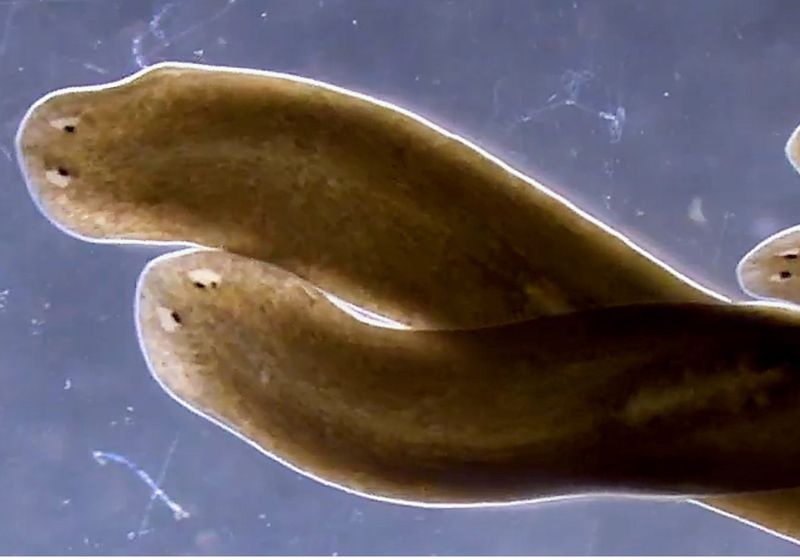Flatworms’ extraordinary ability to regenerate depends on their stem cells’ surrounding environment. But in contrary to what scientists had thought, it’s not the cells in closest proximity to the stem cells that matter most.
Image credit:Stowers Institute for Medical Research
A type of flatworms, called planarians, can regenerate whole organisms from pieces as small as one-279th of their body.1 Depending on how these goofy-looking worms were cut, they could even come back with multiple heads, indicating a precise control of their regenerative capacity.2
A planarian flatworm can regenerate a whole organism from a small fragment of their body. A good understanding of this worm’s superpowers may someday help researchers develop regenerative therapies for humans.
Stowers Institute for Medical Research
Scientists thought that planarians’ superpowers rely on short-distance communication—perhaps even direct contact—between proliferating stem cells and other cells in their environment, also known as a niche. But in a recent Cell Reports study, researchers overturned this idea.3
The team discovered that in regenerating planarians, the closest cells to proliferating stem cells were dispensable, indicating that distance is likely not a vital determinant of the worms’ exceptional regenerative capacity. This work, led by Alejandro Sánchez Alvarado, a molecular biologist at the Stowers Institute for Medical Research, and a postdoctoral fellow in his lab, Frederick Mann, may someday guide researchers’ efforts in developing regenerative therapies for humans.
“This finding challenges our concept of a stem cell ‘niche’ and may significantly advance our understanding of how to control stem cells’ abilities to restore damaged tissues,” said Sánchez Alvarado in a statement.
About 20 to 30 percent of an adult planarian’s body consists of stem cells.4 These cells proliferate rapidly upon injury—such as amputation inflicted by curious scientists—but as disaggregated cells in culture, they rarely divide.5 This suggests that differentiated cells within the stem cell niche drove regeneration. However, researchers didn’t know which cells were responsible.
To induce regeneration, Sánchez Alvarado, Mann, and their colleagues cut off a small segment from planarian tails and allowed them to regenerate for six or 48 hours. They placed 10-15 fragments in a circle surrounding an intact animal, then embedded the arrangement on a tissue block.
The researchers characterized stem cell niches in the fragments by building a spatial transcriptomics map of the regenerating tissue following amputation. To identify different types of specialized cells that surrounded the stem cells, the team used existing single-cell RNA sequencing data from regenerating planarians. Based on the cells’ gene expression profile, they identified two dominant cell types: secretory and intestinal cells.
The team investigated if either cell type directly contacted the stem cells using fluorescent in situ hybridization using markers for these two types of cells, then visualized them under the microscope. The researchers discovered that the arm-like projections of the large, secretory cells—which they called hecatonoblasts after the multiarmed Greek mythological monster Hecatoncheires—were as close as 130nm from stem cells, while the intestinal cells were on average about 10 times farther.
To test how important hecatonoblasts and intestinal cells are for planarian regeneration, the researchers depleted genes associated with each cell type using RNA interference and amputated a portion of the worms’ tail. In contrast to their expectations, only losing the more distant intestinal cells impeded regeneration.
“Because they were located so close to stem cells, we were surprised to find that hecatonoblasts were not controlling their fate nor function, which is counterintuitive to a typical stem cell-niche connection,” Mann said.
Sánchez Alvarado added, “The more we understand how nearby cells and overall signals in the body work together to boost the ability and power of our stem cells, the better we’ll be at creating ways to improve the body’s natural healing.”

